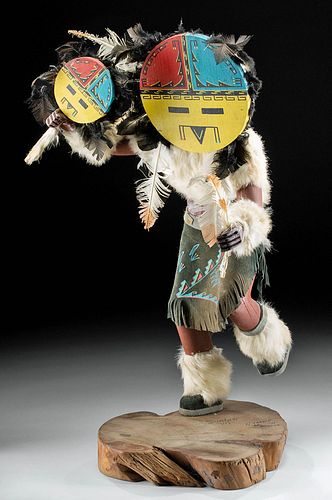Signed 20th C. Navajo Wood Tawa Sun Kachina, Yazzie
Lot 226a
About Seller
Artemis Fine Arts
686 S Taylor Ave, Ste 106
Louisville, CO 80027
United States
Selling antiquities, ancient and ethnographic art online since 1993, Artemis Gallery specializes in Classical Antiquities (Egyptian, Greek, Roman, Near Eastern), Asian, Pre-Columbian, African / Tribal / Oceanographic art. Our extensive inventory includes pottery, stone, metal, wood, glass and textil...Read more
Categories
Estimate:
$1,600 - $2,400
Absentee vs Live bid
Two ways to bid:
- Leave a max absentee bid and the platform will bid on your behalf up to your maximum bid during the live auction.
- Bid live during the auction and your bids will be submitted real-time to the auctioneer.
Bid Increments
| Price | Bid Increment |
|---|---|
| $0 | $25 |
| $300 | $50 |
| $1,000 | $100 |
| $2,000 | $250 |
| $5,000 | $500 |
| $10,000 | $1,000 |
| $20,000 | $2,500 |
| $50,000 | $5,000 |
| $100,000 | $10,000 |
| $200,000 | $20,000 |
About Auction
By Artemis Fine Arts
Mar 24, 2022
Set Reminder
2022-03-24 10:00:00
2022-03-24 10:00:00
America/New_York
Bidsquare
Bidsquare : Exceptional Antiquities Ethnographic Fine Art
https://www.bidsquare.com/auctions/artemis-gallery/exceptional-antiquities-ethnographic-fine-art-9057
Museum-worthy examples of classical antiquities (Egyptian, Greek, Roman, Near Eastern), Viking, Far East / Asian, Pre-Columbian, African / Tribal, Oceanic, Native American, Spanish Colonial, Fossils, Ancient Jewelry, Fine / Visual Arts, so much more! Artemis Fine Arts info@artemisfinearts.com
Museum-worthy examples of classical antiquities (Egyptian, Greek, Roman, Near Eastern), Viking, Far East / Asian, Pre-Columbian, African / Tribal, Oceanic, Native American, Spanish Colonial, Fossils, Ancient Jewelry, Fine / Visual Arts, so much more! Artemis Fine Arts info@artemisfinearts.com
- Lot Description
Native American, Southwestern United States, Navajo or Hopi, 20th to 21st century CE. This is a massive handmade wood, feather, leather, and fur Sun face kachina doll signed by the artist N. Yazzie and identifying mark "TT 400.828." The base is comprised of a cut tree trunk slab, stamped with "HANDCRAFTED BY / NAVAJO INDIANS / AM." The dancer is carved from cotton wood and balances on one foot, dynamic as he dances with one hand raised with a wood sun rattle, the other holding a feather. He is adorned in a painted leather waistcloth and a white rabbit fur arm and ankle bands, and hooded cape. The colorful sun disc set over his face- a yellow bottom half and the upper bisected into red and teal blue halves with black and yellow geometric details and abstract horizontal lines as the eyes; all encircled with black and white feathers. The sun kachina is known as Tawakatsina or Tawa (sometimes Dawa), and is the embodiment of the sun, and contributed to the earth's creation. Size: 12" L x 13" W x 26" H (30.5 cm x 33 cm x 66 cm)
Tawa is part of dances and rituals that celebrate the seasons, solstices, and the sun's movement across the sky, using horizon observations by priests and horizon calendars. These celebrations were in tune with the natural world and harmonized human activity- such as planting and harvests- which reaffirmed the natural order of life.
The Katsinam, supernatural beings who live in the high mountains of the San Francisco Peaks above traditional Hopi territory, speak to the Hopi through costumed dance and song. These dancers emerge from the round ceremonial kivas that are at the center of their communities, singly or in groups, and dance to the music of drums, rattles, and song. Katsina figures (katsina dolls, katsin-tihu), are made of cottonwood root to represent these supernatural beings. Cottonwood is culturally symbolic because the cottonwood tree, once abundant in traditional Hopi lands, grows where water flows - thus, looking across a landscape, lines of cottonwood trees denote a water source in the desert. After carving, the figures are painted all over with whitewash, made from kaolin clay, and then painted in brilliant colors. Originally these were done using yucca brushes. Many katsina are then decorated with other materials, like feathers, cloth, or fur. Katsina dolls are often given objects to hold which indicate their roles.
Provenance: private Newport Beach, California, USA collection
All items legal to buy/sell under U.S. Statute covering cultural patrimony Code 2600, CHAPTER 14, and are guaranteed to be as described or your money back.
A Certificate of Authenticity will accompany all winning bids.
PLEASE NOTE: Due to recent increases of shipments being seized by Australian & German customs (even for items with pre-UNESCO provenance), we will no longer ship most antiquities and ancient Chinese art to Australia & Germany. For categories of items that are acceptable to ship to Australia or Germany, please contact us directly or work with your local customs brokerage firm.
Display stands not described as included/custom in the item description are for photography purposes only and will not be included with the item upon shipping.
#170529Fraying and losses to feathers on head and rattle. Losses to fur pelt on figure's back and discoloration. Stable pressure fissures on kachina figure and wood base. Base is clearly marked and signed by artist. New feathers could easily be attached to fill in any gaps.Condition
- Shipping Info
-
All shipping is handled in-house for your convenience. Your invoice from Artemis Gallery will include shipping calculation instructions. If in doubt, please inquire BEFORE bidding for estimated shipping costs for individual items.
-
- Buyer's Premium



 EUR
EUR CAD
CAD AUD
AUD GBP
GBP MXN
MXN HKD
HKD CNY
CNY MYR
MYR SEK
SEK SGD
SGD CHF
CHF THB
THB
















